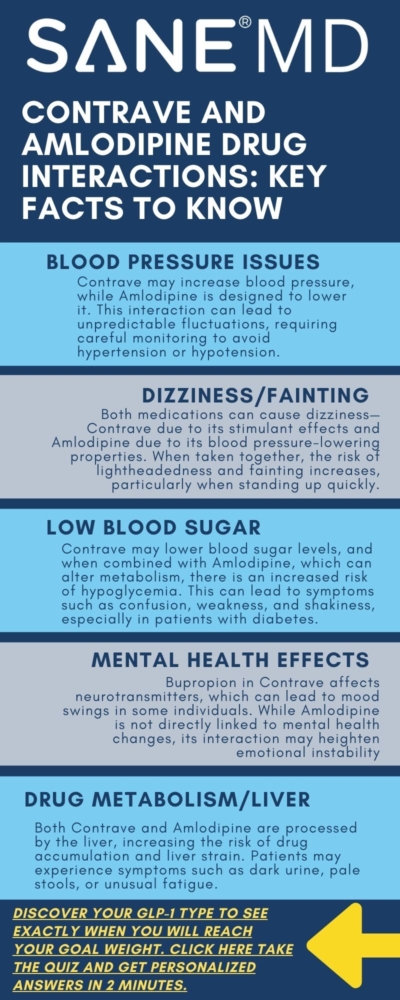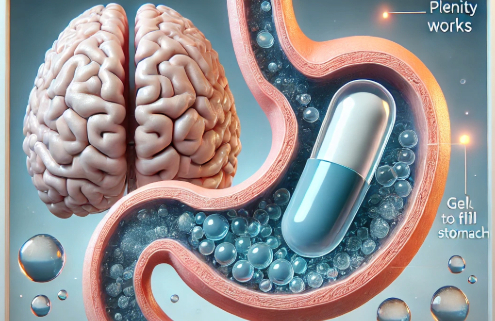Contrave and Amlodipine Drug Interactions: Key Facts to Know

When considering prescription medications, understanding potential drug interactions is essential for safety and effectiveness.
Contrave, a combination drug used for weight loss, and Amlodipine, a common medication for high blood pressure, may interact in ways that affect patient outcomes. Knowing how these medications work together is key to minimizing increased risk of side effects and ensuring effective treatment.
This article explores Contrave and Amlodipine drug interactions, potential side effects, and what you should discuss with your healthcare professional before starting either medication. Our aim is to help you decide if Contrave is the best weight loss solution for you. Remember, if you take both, understanding how they interact can help manage conditions like high blood pressure and weight management safely.
Key Takeaways
- Contrave and Amlodipine may impact blood pressure regulation, requiring close monitoring by your healthcare professional.
- Taking Contrave while on Amlodipine could increase the risk of side effects, such as low blood sugar and mental health changes.
- Always talk with your doctor before adjusting medications to avoid serious allergic reactions or unintended complications.
Contrave and Amlodipine: Key Comparisons
| Factor | Contrave | Amlodipine |
|---|---|---|
| Drug Purpose | Weight loss | Blood pressure management |
| Active Ingredients | Bupropion, Naltrexone | Calcium channel blocker |
| Potential Interactions | Amlodipine, beta blockers, SSRIs, opioids | Contrave, beta blockers, grapefruit juice, alcohol |
| Effects on Blood Pressure | May increase blood pressure | Lowers blood pressure |
| Risk of Low Blood Sugar | Can lower blood sugar, caution with diabetes | Minimal impact on blood sugar |
| Mental Health Considerations | May increase suicidal thoughts, bipolar disorder risk | Not directly linked to mental health changes |
| Warnings & Precautions | Not for patients with eating disorders or opioid use | Avoid grapefruit juice; monitor for dizziness |
How Contrave and Amlodipine Work
Contrave: A Combination Drug for Weight Loss
Contrave is a combination drug that includes bupropion and naltrexone, two medications that work together to influence appetite, cravings, and metabolism.
It is prescribed as part of a weight management plan, typically alongside dietary changes and increased physical activity. But what does Contrave do?
Bupropion: A Dual-Purpose Medication
Bupropion is an extended-release tablet that was originally developed as an antidepressant under the brand name Wellbutrin XL. It belongs to a class of medications that affect mental health conditions by altering the levels of neurotransmitters such as dopamine and norepinephrine.
These neurotransmitters regulate mood, motivate, and reward-driven behaviors, which can influence eating behaviors.
In addition to treating depression and bipolar disorder, bupropion has also been used to assist smoking cessation, marketed as Zyban. The drug’s ability to modulate cravings and impulse control makes it useful for weight loss for certain individuals when combined with naltrexone.
Naltrexone: Opioid Receptor Modulator for Appetite Control
Naltrexone is traditionally used for opioid withdrawal and alcohol dependence, as it works by blocking opioid receptors in the brain. This action reduces the pleasurable effects of substances like alcohol and opioids, helping individuals manage cravings.
When used in Contrave treatment, naltrexone affects the brain’s hypothalamus, the region responsible for hunger and satiety. By modifying the brain’s reward system, naltrexone helps reduce food cravings and emotional eating, making it easier for compatible patients to adhere to a weight loss plan. Drinking alcohol while on Contrave may result in elevated anxiety and heightened agitation.
How Contrave Works for Weight Loss
The combination of bupropion and naltrexone influences both appetite regulation and cravings, creating a dual-action approach to weight management.
Studies have shown that Contrave for weight loss treatment can lead to significant weight loss for certain patients, particularly those with high blood pressure, certain mental health conditions, or metabolic disorders.
Patients taking Contrave should be aware of potential drug interactions and the risk of mental health changes, including suicidal thoughts, particularly in those with a history of bipolar disorder or depression. Side effects may also include low blood sugar, skin rash, and unusual tiredness. Common side effects of Contrave include nausea, constipation, and headache.
Contrave is not suitable for individuals with a history of eating disorders, such as anorexia or bulimia, due to the potential for adverse effects. In fact, healthcare professionals generally avoid prescribing Contrave to individuals with anorexia or bulimia.
Dr. Matthew Olesiak, MD, Chief Medical Director at SANE MD, advises:
“When combining medications like Contrave and Amlodipine, it’s important to track blood pressure changes and mental health status closely. Patients should work with their healthcare provider to adjust doses if necessary, ensuring that weight loss goals align with overall health.”
Amlodipine: A Blood Pressure Medication
Amlodipine is a calcium channel blocker that is widely prescribed for the treatment of high blood pressure and other cardiovascular conditions.
Unlike beta blockers, which primarily reduce heart rate, calcium channel blockers like amlodipine relax blood vessels and improve blood flow, reducing strain on the heart.
Uses of Amlodipine
Amlodipine is used to treat several cardiovascular conditions, including:
- High blood pressure (hypertension) – Amlodipine helps lower blood pressure by preventing calcium from entering muscle cells in the blood vessel walls, allowing them to relax. This improves circulation and decreases the risk of complications such as stroke, heart attack, and kidney disease.
- Amlodipine helps stabilize cardiovascular function in patients with severely high blood pressure (hypertensive crisis prevention).
- Angina (chest pain due to reduced blood flow to the heart) – Amlodipine can increase the risk of low blood pressure if combined with other antihypertensive drugs, requiring dose adjustments.
- Coronary artery disease (CAD) – It improves blood supply to the heart and reduces the frequency of angina episodes.
Potential Interactions and Side Effects
While effective for managing high blood pressure, amlodipine interactions with other medications, including Contrave, can lead to unwanted effects such as:
- Fluctuations in blood pressure
- Increased risk of dizziness and fainting
- Serious allergic reaction, including skin rash and swelling
- Dark urine or pale stools, indicating possible liver issues
- Mental health changes, particularly when combined with bupropion in Contrave treatment
Consuming alcohol while on Amlodipine can heighten the risk of experiencing low blood pressure. Additionally, individuals taking Amlodipine should rise slowly from sitting or lying positions to avoid dizziness or lightheadedness.
Patients taking amlodipine should also be cautious with high-fat foods, as these can interfere with drug effects and absorption.
It’s crucial to talk with your doctor before adjusting dosages or combining it with other drugs like Contrave.
Understanding Contrave and Amlodipine Drug Interactions
When taking Contrave alongside Amlodipine, it is essential to understand how these medications interact. Both drugs affect different bodily systems—Contrave influences metabolism, appetite, and mental health, while Amlodipine primarily regulates blood pressure and cardiovascular function.
Because of their differing effects, certain Contrave drug interactions can occur, potentially altering blood pressure regulation, blood sugar levels, and mental health stability. Some of these interactions may be mild, while others pose a serious warning requiring medical supervision. Additionally, patients taking Contrave alongside other neurological medications should understand potential Contrave and Lamictal drug interactions, as these can impact seizure risk, blood pressure regulation, and central nervous system effects.
Below, we explore the most important interactions that may arise when taking these medications together.
1. Blood Pressure Regulation
Why It Matters:
Both Contrave and Amlodipine affect the cardiovascular system in different ways. Amlodipine lowers high blood pressure by relaxing blood vessels, while Contrave treatment can sometimes increase the risk of hypertension due to its stimulant-like effects from bupropion.
This means that patients taking both medications need careful blood pressure monitoring.
Potential Effects:
- Hypertension (high blood pressure): In some cases, Contrave treatment can cause increased blood pressure, counteracting the effects of Amlodipine.
- Hypotension (low blood pressure): If Contrave causes weight loss and low blood sugar, combined with Amlodipine’s blood pressure-lowering effects, the result may be dizziness or fainting.
- Increased cardiovascular risks: For those with kidney disease, heart conditions, or a history of stroke, blood pressure fluctuations could be dangerous.
Who Should Be Cautious?
Patients with kidney disease, a history of seizure disorder, or severely high blood pressure should consult a healthcare professional before starting Contrave treatment while on Amlodipine.
Taking Contrave in these cases could increase the risk of complications.
2. Risk of Low Blood Sugar
Why It Matters:
Since Contrave affects metabolism and appetite regulation, it can sometimes lower blood glucose levels, leading to low blood sugar (hypoglycemia).
When combined with Amlodipine, which also influences metabolic processes, the risk of hypoglycemia may be further increased.
Potential Effects:
- Symptoms of low blood sugar: Dizziness, confusion, weakness, irritability, or shakiness.
- Worsened effects with beta blockers: If a patient is also taking certain beta blockers alongside Amlodipine, the risk of low blood sugar symptoms increases.
- Fatigue and fainting: Low blood sugar can cause sudden drops in energy, which may be dangerous when combined with Amlodipine’s blood pressure-lowering effects.
Who Should Be Cautious?
- Patients with diabetes or metabolic disorders should monitor their glucose levels while taking Contrave and Amlodipine.
- Individuals who take certain beta blockers alongside these medications should be extra cautious about signs of low blood sugar.
What You Should Do:
- Talk with your doctor about symptoms of low blood sugar.
- If you experience severe dizziness, weakness, or confusion, seek medical attention immediately.
3. Mental Health Considerations
Why It Matters:
One of the most serious warnings associated with Contrave treatment is its impact on mental health conditions. Bupropion, one of the active ingredients, can increase the risk of suicidal thoughts, bipolar disorder symptoms, and mood instability.
While Amlodipine is not directly linked to mental health changes, combining the two may make it harder to detect emotional fluctuations.
Potential Effects:
- Mood swings and depression: Contrave interacts with neurotransmitters, which may cause mental health changes.
- Increased risk of suicidal thoughts: Especially in young adults or those with a history of bipolar disorder or mental health conditions.
- Cognitive impairment: Some patients report unusual tiredness, difficulty concentrating, or emotional numbness.
Who Should Be Cautious?
- Those with a history of mental health conditions, including bipolar disorder, depression, or anxiety.
- Patients who experience serious warning signs like eye pain, skin rash, or mental health changes while taking Contrave treatment.
What You Should Do:
- Talk with your doctor before starting Contrave if you have a history of mental health conditions.
- If you experience suicidal thoughts or severe mood swings, seek medical attention immediately.
Precautions and Warnings
Boxed Warning and Suicidal Thoughts
- The Contrave interactions boxed warning alerts doctors about the risk of suicidal thoughts in young adults and individuals with bipolar disorder.
- Patients with mental health conditions such as bipolar disorder should be monitored closely when starting Contrave treatment.
Risk of Serious Allergic Reaction
- A serious allergic reaction can cause hives, skin rash, swelling, and difficulty breathing.
- If symptoms like pale stools, dark urine, or unusual tiredness develop, seek medical emergency assistance.
Alcohol and Drug Interactions
- Taking Contrave while consuming high fat foods or alcohol may increase the risk of nausea and dizziness.
- Patients should avoid drinking alcohol, especially if they have a seizure disorder or are at risk of opioid withdrawal.
- Those who suddenly stop drinking alcohol after prolonged use may experience withdrawal symptoms and mental health changes.
Other Drug and Vitamin Interactions
- Taking Contrave with other drugs, such as selective serotonin reuptake inhibitors or certain beta blockers, can alter medication effectiveness.
- Vitamin interactions should be considered, particularly with fat-soluble vitamins, which require stable blood pressure for proper absorption.
- Even lab tests can be affected by Contrave treatment, leading to false positive results in some screenings.
Dr. Matthew Olesiak, MD, further adds:
“Certain drug interactions may not be immediately noticeable but can build up over time. That’s why it’s crucial to report any unusual symptoms, such as dizziness, fatigue, or mood shifts, when taking Contrave alongside other medications.”

When to Seek Medical Attention
Signs of Severe Reactions
- Dark urine, pale stools, or unusual tiredness
- Signs of serious allergic reaction, including swelling or difficulty breathing
- Eye pain, blurred vision, or sensitivity to light
- Sudden changes in mental health conditions or suicidal thoughts
If any of these symptoms occur, contact a local emergency number or seek immediate medical attention.
Frequently Asked Questions (FAQs)
When taking Contrave or Amlodipine, understanding potential interactions with other medications is essential for safety.
These FAQs address common concerns about combining Contrave with blood pressure medication, possible drug restrictions, and how Amlodipine interacts with other treatments.
1. Can you take Contrave while on blood pressure medication?
Yes, but with caution. Contrave treatment may increase blood pressure in some individuals, so it’s important to monitor blood pressure levels regularly if you are taking Amlodipine or other blood pressure medications.
In some cases, Contrave interacts with beta blockers and calcium channel blockers, affecting their ability to control high blood pressure.
Patients should talk with their doctor before combining these medications to determine the safest approach.
2. What medications should I avoid with Contrave?
Several medications should not be combined with Contrave, including monoamine oxidase inhibitors (MAOIs), opioid medications, and certain antidepressants like selective serotonin reuptake inhibitors (SSRIs).
Taking Contrave with opioid withdrawal treatments or medications that lower seizure thresholds, such as certain beta blockers, may increase the risk of adverse effects.
Patients should also avoid drugs that interact with bupropion, such as Wellbutrin XL, to prevent excessive dopamine and norepinephrine stimulation.
3. How much does Contrave raise blood pressure?
The effects of Contrave treatment on blood pressure vary from patient to patient. Some individuals experience increased blood pressure and higher heart rates, particularly in the early weeks of starting Contrave. The rise is generally moderate, but patients with severely high blood pressure or certain health conditions may face more significant risks.
It is essential to check blood pressure regularly and report any significant changes to a healthcare professional.
4. Can you take amlodipine besylate and Ozempic together?
Yes, but under medical supervision. Amlodipine besylate is commonly prescribed for high blood pressure, while Ozempic is used for weight loss and type 2 diabetes. When combined, these medications can affect blood sugar levels, increasing the risk of low blood sugar.
Additionally, both drugs influence cardiovascular function, requiring patients to talk with their doctor about potential adjustments in medication dosages to avoid increased risk of dizziness or fainting.
5. What medicine should you not take with Contrave?
Patients should avoid opioid medications, certain antidepressants, and medications that lower seizure thresholds when taking Contrave. Monoamine oxidase inhibitors (MAOIs), used for mental health conditions, must be discontinued at least 14 days before starting Contrave treatment to prevent dangerous drug interactions.
Additionally, combining Contrave with Wellbutrin XL or other bupropion-containing drugs can lead to excessive stimulant-like effects, increasing the chance of mental health changes or serious allergic reaction.
6. Can you take amlodipine and bupropion together?
Yes, but caution is needed. Bupropion, found in Contrave, can slightly elevate blood pressure, while Amlodipine is used to lower it. This combination may result in unpredictable blood pressure fluctuations. Additionally, taking Contrave with Amlodipine may increase the risk of dizziness, headaches, or palpitations.
Patients with kidney disease, heart conditions, or a history of mental health conditions should consult their healthcare professional before combining these medications.
7. What can you not have with amlodipine?
Patients should avoid grapefruit juice, high-fat foods, and certain beta blockers while taking Amlodipine. Grapefruit juice can increase the risk of side effects by altering how Amlodipine is metabolized, and high-fat foods may interfere with absorption, reducing the medication’s effectiveness.
Additionally, combining Amlodipine with other drugs that lower blood pressure—such as beta blockers or diuretics—can lead to excessive drops in blood pressure, increasing the risk of dizziness or fainting.
Always talk with your doctor about potential interactions before making dietary or medication changes.
Conclusion
Understanding their potential interactions is key to ensuring safe and effective treatment when managing both Contrave and Amlodipine. While Contrave regulates appetite and cravings to help manage weight, Amlodipine is widely used to control high blood pressure and improve cardiovascular function. When taken together, these medications may influence blood pressure regulation, blood sugar levels, and mental health stability, making close monitoring essential.
Patients should discuss potential risks with their healthcare professional, especially if they have pre-existing conditions such as kidney disease, seizure disorder, or a history of mental health conditions.
Because Contrave interacts with multiple medications, including beta blockers, opioid withdrawal treatments, and antidepressants, it is important to be aware of possible drug interactions before starting or stopping any medication. While generally well-tolerated, amlodipine can also be affected by dietary factors such as grapefruit juice and high-fat foods, which may alter its effectiveness.
Patients should remain vigilant for signs of low blood sugar, mental health changes, and serious allergic reactions, seeking medical attention if concerning symptoms arise.
Maintaining an open dialogue with a healthcare professional is the best way to ensure that Contrave treatment and Amlodipine therapy align with individual health needs.
Regular monitoring, lifestyle adjustments, and adherence to medical guidance can help patients achieve their weight loss and blood pressure management goals while minimizing risks.

Contrave and Fentanyl Drug Interactions: Risks & Precautions

Combining medications can lead to unexpected and potentially dangerous interactions. Contrave and fentanyl drug interactions pose a significant risk due to the way these drugs affect the body. Contrave is used for chronic weight management, while fentanyl is a powerful opioid for pain relief. Because Contrave contains naltrexone, an opioid antagonist, taking it with fentanyl can result in opioid withdrawal, serious allergic reactions, and other severe health complications.
Understanding these risks and taking proper precautions is essential for anyone using either medication.
Key Takeaways
- Increased Risk of Severe Reactions – Taking Contrave with fentanyl may increase the risk of opioid withdrawal, irregular heartbeat, and serious skin reactions.
- Medical Supervision is Crucial – Patients receiving Contrave should consult a healthcare provider before taking other medicines, especially opioids.
- Potential for Dangerous Side Effects – The combination can lead to low blood sugar, suicidal thoughts, and serious allergic reactions.
What is Contrave?
Contrave (naltrexone bupropion) is a weight loss medication approved for chronic weight management in compatible obese adults and overweight adults with weight-related health conditions.
It combines two active ingredients: naltrexone, an opioid antagonist, and bupropion, an antidepressant used to treat depression and aid in smoking cessation.
How Contrave Works
The medicine affects the brain’s reward and appetite control centers to reduce cravings and regulate food intake.
Unlike some other drugs for weight loss, Contrave does not work by suppressing hunger alone but alters how the brain processes food-related pleasure and impulse control.
Contrave and Fentanyl Drug Interactions
| Interaction Concern | Effect on the Body |
|---|---|
| Opioid Receptor Blockade | Naltrexone in Contrave blocks fentanyl’s effects, leading to sudden opioid withdrawal. |
| Precipitated Withdrawal | Can cause severe nausea, vomiting, sweating, irregular heartbeat, and high blood pressure. |
| Increased Overdose Risk | After naltrexone wears off, opioid receptors become hypersensitive, making fentanyl more potent and increasing the risk of respiratory depression or death. |
| Metabolism Alteration | Bupropion in Contrave affects liver enzymes, leading to unpredictable fentanyl levels, which may cause overdose or reduced pain relief. |
| Serious Side Effects | Risk of suicidal thoughts, serious allergic reactions, and irregular heartbeat when combined. |
Dosage and Administration
Contrave is available as extended-release tablets and should be taken as prescribed by a healthcare provider. High fat meals can increase systemic exposure to bupropion, potentially leading to increased side effects.
Patients taking bupropion should be cautious, as this ingredient has been linked to an increased risk of seizures.
Potential Side Effects
Contrave use is associated with various side effects, including:
- High blood pressure and irregular heartbeat. This is even more likely in the case of Contrave and Amlodipine Drug Interactions.
- Flu-like symptoms, unusual tiredness, and skin rash
- Contrave constipation
- Serious allergic reaction, requiring emergency help
- Suicidal thoughts in patients with mental health conditions or psychiatric illness
- Low blood sugar, particularly in diabetic patients
For more information, see our guide on Contrave side effects and safety considerations for weight loss.
Patients using Contrave may face an increased risk of severe skin reactions, such as Stevens-Johnson syndrome.
“Contrave is an effective weight management tool for certain individuals, but patients must consider the increased risk of side effects, especially when combined with other medicines,” says Dr. Matthew Olesiak, Chief Medical Director at SANE MD. “Anyone using Contrave should be under the close supervision of a healthcare provider, particularly if they are on opioid analgesics or have heart conditions.”
See our comprehensive guide for more information on Contrave drug interactions.
What is Fentanyl?
Fentanyl is a potent opioid analgesic used to treat severe pain, typically in patients treated for cancer or post-surgical pain.
It is significantly stronger than morphine and can cause physical dependence when used long-term.
How Fentanyl Works
Fentanyl binds to opioid receptors in the brain, blocking pain signals and producing feelings of euphoria. This makes it highly effective but also increases the risk of addiction and opioid dependence.
Forms of Fentanyl
Fentanyl is available in multiple dosage forms, including:
- Patches
- Injections
- Lozenges
- Nasal sprays
Risks and Side Effects
Fentanyl can cause severe respiratory depression, leading to life-threatening complications.
Additional side effects include:
- Low blood pressure and irregular heartbeat
- Flu-like symptoms, unusual tiredness, and skin reactions
- Serious allergic reaction and serious skin reactions
- Withdrawal symptoms if stopped suddenly
Contrave and Fentanyl Drug Interactions
Taking Contrave and fentanyl together is not recommended due to significant and potentially life-threatening risks. The primary concern stems from naltrexone, one of Contrave’s key ingredients, which functions as an opioid antagonist.
This means it actively blocks opioid receptors in the brain, preventing fentanyl from producing its typical pain-relieving and euphoric effects. The same risk applies to ALL opioid medications. Please see our guide on Contrave and Codeine drug interactions.
How Naltrexone in Contrave Interferes with Fentanyl
When fentanyl is taken by someone on Contrave, the naltrexone component binds to the same opioid receptors, effectively blocking fentanyl’s action. This can lead to precipitated opioid withdrawal, a condition that occurs when opioids are suddenly removed from the system, leading to severe and rapid withdrawal symptoms.
Unlike traditional opioid withdrawal, which occurs gradually as the drug leaves the body, precipitated withdrawal happens suddenly and intensely due to opioid receptor blockade.
Symptoms of Opioid Withdrawal Triggered by Contrave
Patients who take fentanyl while on Contrave may experience withdrawal symptoms such as:
- Severe nausea, vomiting, and sweating – The body reacts to the sudden loss of opioid activation, triggering gastrointestinal distress and excessive sweating.
- Irregular heartbeat and high blood pressure – The abrupt shift in the body’s neurochemical balance can strain the cardiovascular system, leading to dangerous fluctuations in heart rate and blood pressure.
- Flu-like symptoms and unusual tiredness – Withdrawal can cause extreme fatigue, body aches, chills, and fever-like symptoms.
- Suicidal thoughts in patients with bipolar disorder or psychiatric illness – Opioid withdrawal can severely impact mental health, especially in individuals already dealing with mood disorders.
Increased Risk of Overdose After Naltrexone Use
Another serious concern is the increased risk of overdose if fentanyl is taken after Contrave. The combined medicine effects of Contrave and fentanyl can increase the risk of overdose, especially if opioids are taken after naltrexone has blocked their effects.
Once naltrexone wears off, opioid receptors may become hypersensitive, meaning a previously tolerated dose of fentanyl could become dangerously potent. This can result in severe respiratory depression, unconsciousness, or even death. This risk is especially high because fentanyl is 50-100 times more potent than morphine and even small amounts can cause fatal overdoses.
Patients taking Contrave should be aware of these risks and consult their healthcare provider before using any opioid medications.
How Contrave Alters Fentanyl’s Metabolism
Apart from opioid receptor blockade, Contrave’s bupropion component also affects the metabolism of certain medicines, including opioids. Bupropion inhibits enzymes in the liver that break down drugs, meaning it can alter how fentanyl is processed in the body. This can result in:
- Unpredictable drug levels – Some individuals may experience either a weakened or prolonged fentanyl effect.
- Heightened risk of respiratory depression – If fentanyl levels rise unexpectedly, it can lead to dangerous breathing difficulties, the primary cause of opioid overdose deaths.
Importance of Medical Supervision
Due to these risks, individuals taking Contrave should consult their healthcare provider before using fentanyl or other opioid analgesics.
Patients receiving Contrave for weight loss or chronic weight management should disclose any past or current opioid use to their doctor to avoid dangerous interactions.
“Many people don’t realize that taking Contrave while on opioid analgesics like fentanyl can result in sudden opioid withdrawal, which can be dangerous,” says Dr. Matthew Olesiak, Chief Medical Director at SANE MD. “It’s critical to speak with a healthcare provider before combining these certain medicines, as doing so can increase the risk of severe health consequences.”
Precautions and Recommendations
If you are taking Contrave or considering it for weight loss, it is important to take proper precautions to avoid serious health risks, especially when using other medicines like fentanyl.

Below are critical safety steps to follow:
1. Inform Your Healthcare Provider About All Medications
Always inform your healthcare provider about any prescription, over-the-counter, or herbal supplements you are taking. This includes other antidepressants, opioid analgesics, tricyclic antidepressants, and systemic corticosteroids. Certain medicines can interfere with Contrave’s effectiveness, increase the risk of seizures, or cause serious allergic reactions.
Additionally, missed doses of Contrave should not be doubled, as this could raise the risk of seizures and adverse reactions.
2. Avoid Alcoholic Beverages
Drinking alcoholic beverages while taking Contrave can increase the risk of serious allergic reactions, irregular heartbeat, and low blood sugar. Alcohol use disorder is also a concern, as bupropion, one of Contrave’s ingredients, has been associated with an increased risk of suicidal thoughts and mental health conditions in certain individuals.
Those who drink alcohol regularly should discuss their consumption with a healthcare provider before starting Contrave.
3. Never Stop Taking Fentanyl Abruptly if You Are Opioid-Dependent
If you are opioid-dependent, do not stop fentanyl suddenly while on Contrave, as this can potentially lead to severe opioid withdrawal symptoms. This may include flu-like symptoms, unusual tiredness, increased heart rate, and dangerously high blood pressure.
Any dose reduction or changes in opioid use should be done under medical supervision to prevent withdrawal complications.
4. Monitor for Serious Skin Reactions
Some individuals may develop serious skin reactions, such as skin rash, hives, or life-threatening allergic reactions. If you notice skin irritation, blistering, or flu-like symptoms accompanying a rash, seek medical attention immediately.
Patients on systemic corticosteroids should be particularly cautious, as they may have an altered immune response to skin reactions.
5. Monitor Blood Sugar Levels, Especially for Diabetic Patients
Patients receiving Contrave for chronic weight management and those with diabetes should closely monitor their blood sugar levels. Since Contrave can lead to low blood sugar, adjustments to diabetes medications or dietary plans may be necessary.
Maintaining a reduced-calorie diet and discussing any symptoms of low blood sugar with a healthcare provider is recommended.
6. Watch for Mental Health Changes
Since Contrave contains bupropion, it can affect mental health conditions, particularly in those with bipolar disorder, psychiatric illness, or major depressive disorder. Be vigilant for warning signs such as increased suicidal thoughts, unusual tiredness or fatigue, severe mood swings or agitation, irrational behavior or increased anxiety. Monitoring mental health changes is also crucial if you’re taking Contrave and Prozac together, as drug interactions can be particularly severe.
If you experience any of these symptoms, seek emergency help or consult your healthcare provider immediately.
7. Avoid High-Fat Meals When Taking Contrave
High-fat meals can increase the absorption of naltrexone bupropion, leading to a higher risk of side effects like nausea, dizziness, and irregular heartbeat.
To minimize risks, take Contrave’s extended-release tablets with a light or moderate meal instead of a heavy one.
8. Special Considerations for Pregnant and Breastfeeding Women
Women who are pregnant or breastfeeding should not take Contrave, as its ingredients can pass into breast milk and may cause harm to a newborn. If you are planning to become pregnant or are nursing, consult a healthcare professional about safer weight management alternatives.
9. Be Aware of Potential Drug Interactions
Contrave interacts with certain medicines, including other antidepressants (such as SSRIs, SNRIs, and tricyclic antidepressants), smoking cessation drugs, opioid analgesics, which can lead to opioid withdrawal. (Patients must discontinue opioids 7 to 10 days before initiating Contrave and should understand how long Contrave stays in their system to prevent interactions and to avoid withdrawal symptoms), over-the-counter medications and supplements, and other weight loss medications, which may have overlapping effects.
Consult your healthcare provider before adding or stopping any medication to avoid dangerous interactions.
10. Know When to Seek Emergency Help
Seek emergency help if you experience life-threatening symptoms such as severe allergic reaction (swelling of the face, lips, or throat, heart attack symptoms (chest pain, shortness of breath, or arm pain), severe suicidal thoughts or unusual behavior changes, seizures or loss of consciousness. Following these precautions and recommendations can significantly reduce the increased risk of serious side effects when using Contrave.
Always work closely with a healthcare provider to ensure the safest approach to weight management and medication use.
Frequently Asked Questions (FAQ)
When taking Contrave or fentanyl, it is essential to understand potential drug interactions and safety concerns.
Below are common questions regarding the risks and precautions associated with these medications.
1. Can you take Contrave with opioids?
You should not take Contrave with opioids. Contrave contains naltrexone, an opioid antagonist, which blocks the effects of opioids and can cause sudden opioid withdrawal if opioids are still in your system. This can lead to severe withdrawal symptoms such as nausea, vomiting, irregular heartbeat, flu-like symptoms, and high blood pressure.
If you are currently using opioids and want to start Contrave, you must consult your healthcare provider about safely discontinuing opioids first.
2. What medications should not be taken with fentanyl?
Fentanyl interacts with multiple medications, potentially leading to severe side effects, including respiratory depression, irregular heartbeat, and increased risk of overdose. Medications to avoid while taking fentanyl include opioid antagonists like naltrexone (found in Contrave), other opioid analgesics, tricyclic antidepressants, certain sedatives (benzodiazepines, barbiturates, or muscle relaxants), and systemic corticosteroids.
Combining fentanyl with these drugs can increase the risk of life-threatening side effects. Always inform your healthcare provider of any medications you take before starting fentanyl.
3. What medications should you avoid while taking Contrave?
Several medicines should not be taken with Contrave, including opioids, antidepressants (such as SSRIs, SNRIs, and tricyclic antidepressants), seizure medications, and over-the-counter stimulant-based weight loss medications. Opioids should be avoided due to naltrexone’s opioid-blocking effects, which can lead to opioid withdrawal.
Additionally, Contrave contains bupropion, which can lower the seizure threshold, increasing the risk of seizures when combined with other stimulant medications or alcohol. Always check with your healthcare provider before adding or discontinuing any medications while on Contrave.
4. Does naltrexone affect fentanyl?
Naltrexone directly affects fentanyl by blocking its opioid receptors, preventing it from providing pain relief or causing euphoria. This is because naltrexone is an opioid antagonist, meaning it reverses or negates the effects of opioids like fentanyl. If someone taking fentanyl takes naltrexone suddenly, it can lead to immediate opioid withdrawal, causing intense flu-like symptoms, irregular heartbeat, and dangerously high blood pressure.
Additionally, taking fentanyl after stopping naltrexone can increase the risk of overdose, as the body becomes more sensitive to opioids once the antagonist effect wears off.
5. What happens if you take opioids with Contrave?
If you take opioids with Contrave, you may experience opioid withdrawal, as naltrexone in Contrave blocks opioid receptors, preventing opioids from working. This can cause severe nausea, sweating, vomiting, high blood pressure, and flu-like symptoms. Additionally, using opioids after Contrave wears off can lead to a higher risk of overdose, as opioid receptors may become hypersensitive after being blocked.
If you are currently taking opioids and want to start Contrave, consult a healthcare provider to safely transition off opioids first.
Conclusion
The interaction between Contrave and fentanyl presents serious health risks, including opioid withdrawal, increased risk of overdose, irregular heartbeat, and serious allergic reactions. Because Contrave contains naltrexone, an opioid antagonist, it blocks the effects of fentanyl, which can trigger sudden and severe withdrawal symptoms. Additionally, taking fentanyl after Contrave has worn off can increase the risk of overdose, as opioid receptors become more sensitive.
Patients considering Contrave for weight management should carefully review their medical history and any current medications with their healthcare provider. Those using opioids for pain management must take extra precautions to avoid harmful interactions. Other medicines, including antidepressants, seizure medications, and certain weight loss drugs, may also pose risks when combined with Contrave.
Understanding the potential dangers and drug interactions associated with these medications is essential for making informed health decisions. If you are currently on Contrave or fentanyl, or plan to start either, consult your healthcare provider to ensure safe and effective treatment while minimizing risks.

Contrave and Mounjaro Together: Potential Drug Interactions

The use of Contrave and Mounjaro together for weight loss has sparked interest among individuals seeking effective treatment options. As two FDA-approved weight loss medications, Contrave and Mounjaro work through different mechanisms, raising questions about their potential synergy and possible drug interactions.
While some patients may see promising weight loss benefits with these two medications, there are critical safety considerations to address.
This article explores how taking Contrave and taking Mounjaro may affect the body, their combined impact on body mass index and weight loss, and the precautions necessary for safe use.
Key Takeaways
- Contrave and Mounjaro work differently for weight loss. While Contrave suppresses appetite and reduces food cravings, Mounjaro affects gut hormones to improve insulin sensitivity and regulate blood sugar levels.
- Combining these medications may increase the risk of side effects. Patients taking Mounjaro and Contrave together should be aware of potential interactions, including changes in blood pressure, mood, and digestive issues.
- Consulting a healthcare provider is essential. Anyone considering Contrave and Mounjaro together should discuss their weight loss goals, family history, and other medications with their doctor before starting a treatment plan.
Understanding Contrave and Mounjaro
Contrave is a prescription weight loss medication, a combination medication of two active ingredients: bupropion, an antidepressant and smoking cessation aid, and naltrexone, an opioid antagonist. This combination helps suppress appetite and reduce food cravings, helping compatible individuals lose weight.
Contrave is approved by the FDA for chronic weight management in adults who have a BMI of 30 or higher, or a BMI of 27 accompanied by at least one weight-related medical condition.
Mounjaro is an injectable medication that belongs to the GLP-1 and GIP receptor agonist families. Originally approved for type 2 diabetes, its weight-loss benefits have made it a popular option for those with weight-related health conditions seeking long-term weight reduction.
This once-weekly injection regulates blood sugar levels, enhances insulin sensitivity, and slows digestion, reducing calorie intake.
Contrave and Mounjaro – Comparison and Potential Interactions
| Category | Contrave | Mounjaro |
|---|---|---|
| Mechanism of Action | Suppresses appetite, reduces cravings | Regulates blood sugar, slows digestion, reduces hunger |
| Active Ingredients | Bupropion (antidepressant), Naltrexone (opioid antagonist) | Tirzepatide (GLP-1 and GIP receptor agonist) |
| FDA Approval | Chronic weight management (BMI ≥30, or BMI ≥27 with comorbidities) | Originally for type 2 diabetes, now used for weight loss |
| Dosing | Oral tablets, taken daily | Weekly injection (arm, thigh, or abdomen) |
| Primary Weight Loss Effects | Reduces emotional eating and cravings | Enhances insulin sensitivity, delays gastric emptying |
| Common Side Effects | Nausea, constipation, dry mouth, increased blood pressure, mood changes | Nausea, bloating, delayed digestion, low blood sugar |
| Potential Drug Interactions | Interacts with opioids, MAO inhibitors, and stimulants | May amplify effects of insulin, diabetes medications |
| Impact on Blood Sugar | Indirectly affects metabolism and calorie intake | Lowers blood sugar, improves insulin sensitivity |
| Impact on Blood Pressure | May increase blood pressure | May lower blood pressure |
| Mood Effects | May cause mood changes, anxiety, or suicidal thoughts | No direct effect, but metabolic changes may impact mood |
| Ideal for Individuals Who… | Struggle with emotional eating or compulsive snacking | Need improved insulin function and appetite regulation |
| Monitoring Considerations | Blood pressure, mood changes, drug interactions | Blood sugar levels, digestive changes, fatigue |
| Best Used With… | Calorie-restricted diet, exercise | Balanced diet, regular exercise |
How Contrave and Mounjaro Affect Weight Loss
Both Contrave and Mounjaro are FDA-approved weight loss medications, but they function through distinct mechanisms in the body. Understanding how each medication works can help patients determine which option—or combination—is best suited for their needs.
Contrave: Targeting the Brain’s Reward System
How does Contrave work for weight loss? Contrave is an oral weight loss medication that combines two active ingredients:
- Bupropion, an antidepressant that influences dopamine and norepinephrine levels, helping regulate appetite and mood.
- Naltrexone, an opioid antagonist that alters the brain’s reward response to food, making eating less pleasurable.
These ingredients work together to help individuals suppress appetite, reduce food cravings, and minimize emotional eating. This can be particularly beneficial for people who struggle with stress eating or compulsive snacking.
Contrave is most effective for weight loss when combined with a calorie-restricted diet and regular exercise, as its primary role is to help certain patients stick to their diet by curbing the urge to overeat.
Mounjaro: Enhancing Insulin Sensitivity and Hunger Control
Mounjaro is an injectable medication from the agonist family of GLP-1 and GIP receptor agonists. Mounjaro acts by imitating gut hormones, effectively reducing appetite and cravings by targeting the brain’s appetite control center. Essentially, it mimics the effects of gut hormones that play a role in:
- Regulating blood sugar – Improves insulin sensitivity, which helps the body use glucose more effectively.
- Delaying gastric emptying – Slows digestion, keeping individuals feeling fuller for longer and reducing calorie intake.
- Suppressing appetite – Affects brain receptors that control hunger and satiety.
Originally developed for type 2 diabetes, Mounjaro has shown considerable weight loss benefits in both diabetic and non-diabetic participants struggling with obesity. The medication is typically administered as a once-weekly injection in the upper arm, thigh, or abdomen.
Comparing Weight Loss Effects: Contrave vs. Mounjaro
Clinical studies indicate that taking Mounjaro can lead to a higher percentage of average weight loss compared to Contrave. Mounjaro’s impact on gut hormones and insulin sensitivity often results in more significant weight reduction, particularly for certain individuals with metabolic conditions such as high blood pressure, high cholesterol, or insulin resistance.
However, Contrave remains a valuable option for patients whose primary challenge is resisting food cravings. It is especially effective in people who eat in response to emotions rather than true hunger.
A treatment group experienced notable weight loss effects when using Mounjaro, particularly when combined with a calorie-restricted diet and regular exercise. Meanwhile, Contrave demonstrated effectiveness in aiding non-diabetic participants who struggled with emotional and habitual eating patterns.
Ultimately, both medications have their place in weight loss treatment. The best option depends on individual weight loss goals, eating behaviors, and underlying health conditions.
Potential Drug Interactions Between Contrave and Mounjaro
While both Contrave and Mounjaro are effective weight loss medications, combining them may lead to unexpected effects. Each drug influences the body differently, and using them together could amplify or counteract certain responses.
Before taking Contrave and Mounjaro together, patients should understand the potential risks and consult a healthcare provider to ensure safe use.
1. Changes in Blood Sugar Levels
One of the primary concerns when combining these medications is the impact on blood sugar levels.
- Mounjaro lowers blood sugar by improving insulin sensitivity and slowing digestion. This is particularly beneficial for individuals with type 2 diabetes or non-diabetic participants struggling with insulin resistance. However, in some cases, the medication can lead to low blood sugar, causing dizziness, fatigue, or shakiness.
- Contrave’s effect on metabolism can interfere with glucose regulation. While it does not directly alter insulin function like Mounjaro, it can affect energy balance and calorie intake, which may lead to unpredictable shifts in blood sugar levels.
For patients using both medications, frequent blood glucose monitoring is essential to prevent hypoglycemia or excessive dips in energy levels. The same drug interaction effects can occur by taking Contrave and Metformin together.
2. Blood Pressure Fluctuations
Blood pressure regulation is another key concern when using Contrave and Mounjaro together.
- Contrave may raise blood pressure, particularly in the early stages of treatment. This is due to its active ingredients, which stimulate the central nervous system and increase heart rate. For patients with high blood pressure or high cholesterol, this could pose a significant risk.
- Mounjaro, on the other hand, may lower blood pressure by improving metabolic function and reducing insulin sensitivity. While this can be beneficial for cardiovascular health, combining it with Contrave may create an unpredictable balance—potentially causing sudden spikes or drops in blood pressure.
Patients with a history of high blood pressure should work closely with their healthcare provider to monitor their cardiovascular health and adjust dosages as needed.
3. Mood Changes and Suicidal Thoughts
One of the lesser-known but serious risks associated with taking Contrave is its potential impact on mood.
- Bupropion, a key ingredient in Contrave, is an antidepressant, meaning it alters brain chemistry to influence dopamine and norepinephrine levels. While this can help with food cravings and emotional eating, it can also contribute to mood changes, anxiety, or agitation in some individuals.
- Some patients have reported increased suicidal thoughts while using Contrave. This risk is particularly high for individuals with a history of depression or mental health conditions.
While Mounjaro is not directly linked to mood-related side effects, its influence on metabolic function and energy expenditure may indirectly impact emotional well-being.
Patients experiencing mood swings, depression, or thoughts of self-harm should discontinue use and seek medical attention immediately.
Doctor’s Perspective on Drug Interactions
Dr. Matthew Olesiak, MD, Chief Medical Director of SANE MD, stresses the importance of medical supervision when considering this combination:
“While Contrave and Mounjaro offer unique weight loss benefits, combining them without medical supervision can lead to unpredictable effects, especially for individuals managing high blood pressure or other medications that affect metabolism.”
Given the complexity of these medications, patients should never adjust dosages or combine treatments without first consulting their doctor.
Regular check-ups, blood pressure monitoring, and tracking any mood-related symptoms are essential steps in ensuring safe use.

Who Should Consider This Combination?
Patients with high cholesterol, high blood pressure, or a family history of metabolic disorders should be cautious when considering Contrave and Mounjaro together.
A healthcare provider may recommend:
- Starting with a low dose of one medication before introducing the second.
- Monitoring blood pressure and blood sugar levels regularly.
- Following a balanced diet and regular exercise plan to maximize results.
Side Effects to Watch For
Both Contrave and Mounjaro are effective weight loss medications, but they come with potential side effects.
When combined, these risks may be amplified, making it essential for patients to monitor their response and consult a healthcare provider if any issues arise.
1. Digestive Issues
Gastrointestinal side effects are among the most commonly reported issues with both medications.
- Contrave can cause nausea, vomiting, constipation, and dry mouth. This is due to its impact on the central nervous system and digestive processes. The medication influences appetite regulation in the brain, but it can also slow bowel movements and decrease saliva production, leading to discomfort. Check out our guide to Contrave drug interactions for more symptoms.
- Mounjaro delays gastric emptying, which may lead to nausea, bloating, and in some cases, diarrhea. While this mechanism helps reduce calorie intake, it can also cause prolonged feelings of fullness, making it difficult for some individuals to eat regular meals.
When used together, these medications may intensify digestive discomfort, leading to prolonged nausea or constipation.
Patients should ensure they stay hydrated and consume a fiber-rich balanced diet to support digestion.
2. Blood Sugar Fluctuations
Because taking Mounjaro directly affects blood sugar levels by improving insulin sensitivity, it can increase the risk of low blood sugar (hypoglycemia), particularly when combined with other medications that impact metabolism.
- Mounjaro slows glucose absorption, which can lead to dizziness, fatigue, and lightheadedness if blood sugar drops too low.
- Contrave, while not a diabetes medication, affects the body’s energy balance and may indirectly interfere with glucose regulation.
For patients without diabetes, this interaction may not be as pronounced.
However, those with metabolic conditions or a history of unstable blood glucose should monitor for signs of low blood sugar, including headaches, shakiness, and irritability.
3. Blood Pressure Changes
Both medications have opposing effects on blood pressure, making it crucial for individuals with hypertension or cardiovascular concerns to exercise caution.
- Contrave may increase blood pressure, especially in the initial stages of use or at a higher dose. Its stimulant-like effect on the nervous system can raise heart rate, which may be problematic for those with a history of high blood pressure or high cholesterol.
- Mounjaro, on the other hand, can lower blood pressure due to its effect on metabolic health and insulin regulation.
When taking Contrave and Mounjaro together, some patients may experience fluctuations between high and low blood pressure, which can lead to dizziness, fatigue, or an increased risk of fainting.
Those with preexisting hypertension should monitor their readings closely and discuss any unusual symptoms with their doctor.
4. Fatigue and Insomnia
Changes in energy levels are common with both medications, but for different reasons.
- Contrave can cause restlessness and difficulty sleeping, particularly in the beginning stages. It contains bupropion, a mild stimulant that may increase wakefulness and disrupt sleep cycles, leading to insomnia.
- Mounjaro regulates energy expenditure and can sometimes cause fatigue, particularly if blood sugar levels fluctuate too much.
When combined, these effects may lead to increased daytime tiredness while also causing nighttime restlessness.
Establishing a consistent sleep routine, avoiding caffeine late in the day, and discussing medication timing with a healthcare provider may help minimize disruptions.
Doctor’s Perspective on Managing Side Effects
Dr. Olesiak emphasizes the importance of monitoring side effects and making early adjustments:
“Patients taking Contrave or taking Mounjaro should pay close attention to side effects and report any concerns to their healthcare provider. Adjusting the treatment plan early can prevent serious complications.”
Because every individual responds differently to anti-obesity medications, it’s crucial to stay aware of how the body reacts and address any concerns promptly.
If side effects become severe or persistent, a healthcare provider may recommend a low dose adjustment or an alternative weight loss treatment.
Frequently Asked Questions (FAQ)
Many people who consider Contrave and Mounjaro together or as part of a broader weight loss treatment have concerns about medication interactions, safety, and how to maximize weight loss benefits.
Below are answers to common questions to help clarify potential risks and best practices when using these weight loss medications.
1. What medications should not be taken with Contrave?
Several other medications, including opioids, may interact with taking Contrave. For example, combining Contrave and fentanyl should be avoided due to potentially severe drug interactions. This is because Contrave contains naltrexone, which blocks opioid receptors and can cause sudden withdrawal symptoms in individuals using painkillers.
Additionally, other antidepressants, especially MAO inhibitors (such as phenelzine or selegiline), can increase the risk of dangerous side effects, including high blood pressure and serotonin syndrome. Stimulants, seizure medications, and drugs affecting blood pressure should also be used with caution.
Always consult a healthcare provider before starting Contrave if you are on other treatments.
2. Can you take Contrave and semaglutide at the same time?
Semaglutide, the active ingredient in Wegovy and Ozempic, is another GLP-1 receptor agonist similar to taking Mounjaro. In theory, Contrave and semaglutide could be used together, but combining them may increase the likelihood of nausea, gastrointestinal side effects, and blood sugar fluctuations.
Additionally, Contrave has a stimulant effect, while semaglutide works by slowing digestion—together, this could create unpredictable metabolic responses.
A healthcare provider can help determine whether combining these weight loss medications is safe for your specific needs and weight loss goals.
3. Can I take bupropion with Mounjaro?
Bupropion, a component of Contrave, is sometimes prescribed separately as an antidepressant or smoking cessation aid. While there is no direct contraindication for taking bupropion with Mounjaro, caution is advised. Bupropion can increase heart rate and raise blood pressure, while Mounjaro may lower it, leading to unpredictable cardiovascular effects.
Additionally, since bupropion influences dopamine and norepinephrine levels, patients should monitor for mood changes or increased anxiety.
Always discuss the potential risks and benefits with a healthcare provider before combining these medications.
4. How to speed up weight loss on Mounjaro?
To enhance Mounjaro’s weight-loss effects, patients should focus on maintaining a calorie-restricted diet, incorporating regular exercise, and prioritizing lifestyle changes. Eating a balanced diet rich in protein, fiber, and healthy fats can support satiety, while minimizing processed foods and excessive sugars will help regulate blood sugar levels. Strength training and cardiovascular exercise can further improve energy expenditure and metabolic function.
Additionally, staying consistent with the once-weekly injection schedule and monitoring progress with a healthcare provider can optimize results.
5. What medications should not be taken with Contrave?
In addition to opioid painkillers and MAO inhibitors, taking Contrave should be avoided alongside medications that lower seizure thresholds, such as tramadol or antipsychotic drugs. Combining Contrave with other stimulant-like medications, including amphetamines or certain ADHD treatments, may lead to increased blood pressure and heart rate, which could be dangerous.
Since Contrave also affects mood and appetite regulation, individuals taking antidepressants, mood stabilizers, or other psychiatric medications should consult their doctor to ensure safe use.
Always review your full medication list with a healthcare provider before starting Contrave.
This FAQ section provides essential information for anyone considering Contrave and Mounjaro together or looking for ways to optimize their weight loss journey. If you have additional concerns, speaking with a medical professional is the best way to ensure safe and effective treatment.
Final Thoughts on Combining Contrave and Mounjaro
While Contrave and Mounjaro together may provide enhanced weight loss effects, this combination is not suitable for everyone.
Patients should prioritize safety, understand Contrave interact risks, and work with a doctor to create a sustainable weight loss treatment plan.
A well-rounded treatment plan includes:
- A calorie-restricted diet and a healthy diet
- Regular exercise and lifestyle changes
- Careful monitoring of other medications and health conditions
Before starting any new medications, consult a healthcare provider to determine the safest and most effective approach for long-term chronic weight management.





















